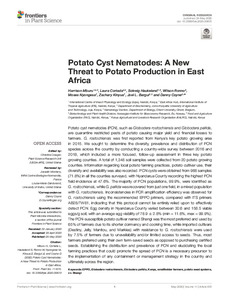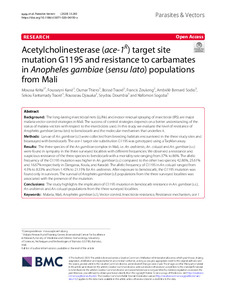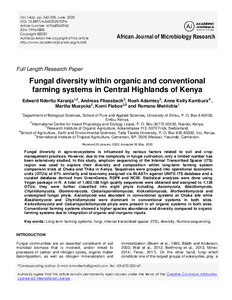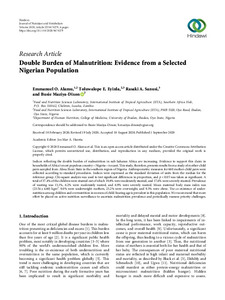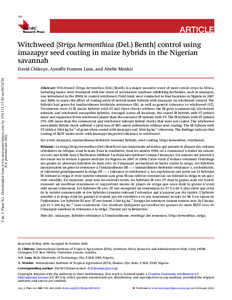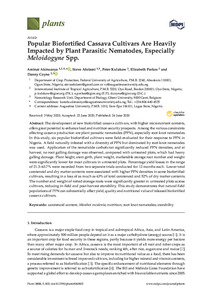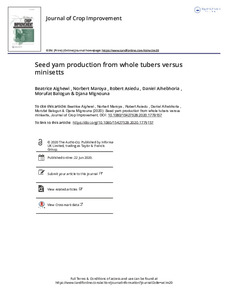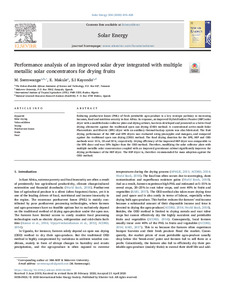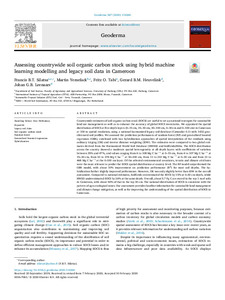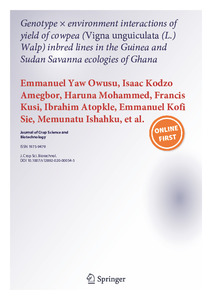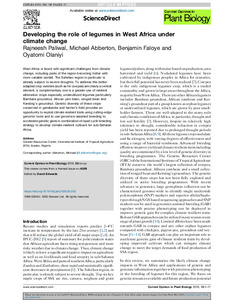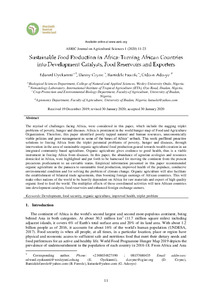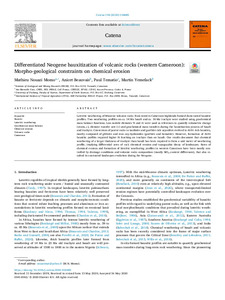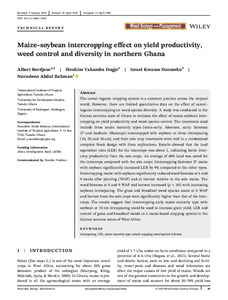Welcome to the International Institute of Tropical Agriculture Research Repository
Journal and Journal Articles: Recent submissions
Now showing items 541-560 of 5157
-
Soil quality and soil fertility status in major soil groups at the Tombel area, South-West Cameroon
(2020-02)Among the greatest challenges of Sub-Saharan Africa is the need for more crop production for supplying the increasing demand of its growing population. For this purpose, knowledge on soil resources and their agricultural potentials is important for defining proper and appropriate land use and management. We thus investigated on the status of soil fertility in Tombel area, in order to produce such knowledge through understanding and monitoring the impact of physicochemical properties of soil. Diverse ... -
Potato cyst nematodes: a new threat to potato production in east Africa
(2020)Potato cyst nematodes (PCN), such as Globodera rostochiensis and Globodera pallida, are quarantine restricted pests of potato causing major yield and financial losses to farmers. G. rostochiensis was first reported from Kenya’s key potato growing area in 2015. We sought to determine the diversity, prevalence and distribution of PCN species across the country by conducting a country-wide survey between 2016 and 2018, which included a more focused, follow-up assessment in three key potato growing ... -
Acetylcholinesterase (ace‑1R) target site mutation G119S and resistance to carbamates in Anopheles gambiae (sensu lato) populations from Mali
(2020)Background The long-lasting insecticidal nets (LLINs) and indoor residual spraying of insecticide (IRS) are major malaria vector control strategies in Mali. The success of control strategies depends on a better understanding of the status of malaria vectors with respect to the insecticides used. In this study we evaluate the level of resistance of Anopheles gambiae (sensu lato) to bendiocarb and the molecular mechanism that underlies it. Methods Larvae of An. gambiae (s.l.) were collected ... -
Fungal diversity within organic and conventional farming systems in Central Highlands of Kenya
(2020)Fungal diversity in agro-ecosystems is influenced by various factors related to soil and crop management practices. However, due to the complexity in fungal cultivation, only a limited number has been extensively studied. In this study, amplicon sequencing of the Internal Transcribed Spacer (ITS) region was used to explore their diversity and composition within long-term farming system comparison trials at Chuka and Thika in Kenya. Sequences were grouped into operational taxonomic units (OTUs) at ... -
Founder events influence structures of Aspergillus flavus populations
(2020-08)In warm regions, agricultural fields are occupied by complex Aspergillus flavus communities composed of isolates in many vegetative compatibility groups (VCGs) with varying abilities to produce highly toxic, carcinogenic aflatoxins. Aflatoxin contamination is reduced with biocontrol products that enable atoxigenic isolates from atoxigenic VCGs to dominate the population. Shifts in VCG frequencies similar to those caused by the introduction of biocontrol isolates were detected in Sonora, Mexico, ... -
Double burden of malnutrition: evidence from a selected Nigerian population
(2020-09-01)Indices reflecting the double burden of malnutrition in sub-Saharan Africa are increasing. Evidence to support this claim in households of Africa’s most populous country—Nigeria—is scant. This study, therefore, presents results from a study of mother-child pairs sampled from Akwa Ibom State in the southern region of Nigeria. Anthropometric measures for 660 mother-child pairs were collected according to standard procedures. Indices were expressed as the standard deviation of units from the median ... -
Taxonomic revision of the afrotropical Phytomia gerin-meneville (Diptera: syrphidae)
(2020)The Afrotropical representatives of the hoverfly genus Phytomia Guérin-Méneville (Diptera) are revised. In total, 19 species are recognized of which three are new to science: Phytomia austeni sp. nov., P. memnon sp. nov., and P. pallida sp. nov. Phytomia neavei Bezzi is considered a junior synonym of P. kroeberi (Bezzi), P. noctilio Speiser a junior synonym of P. pubipennis Bezzi, and P. ephippium Bezzi a junior synonym of P. melas (Bezzi). Lectotypes are designated for the following species: ... -
Witchweed [Striga hermonthica (Del.) Benth] control using imazapyr seed coating in maize hybrids in the Nigerian savannah
(2020-08)Witchweed [Striga hermonthica (Del.) Benth] is a major parasitic weed of most cereal crops in Africa, including maize. Seed treatment with low doses of acetolactate synthase–inhibiting herbicides, such as imazapyr, was introduced in the 1990s to control witchweed. Field trials were conducted in four locations in Nigeria in 2007 and 2008, to assess the effect of coating seeds of several maize hybrids with imazapyr on witchweed control. The hybrids had genes for imidazolinone herbicide resistance ... -
Popular biofortified cassava cultivars are heavily impacted by plant parasitic nematodes, especially Meloidogyne Spp.
(2020)The development of new biofortified cassava cultivars, with higher micronutrient contents, offers great potential to enhance food and nutrition security prospects. Among the various constraints affecting cassava production are plant parasitic nematodes (PPN), especially root-knot nematodes. In this study, six popular biofortified cultivars were field-evaluated for their response to PPN in Nigeria. A field naturally infested with a diversity of PPN but dominated by root-knot nematodes was used. ... -
Seed yam production from whole tubers versus minisetts
(2020)Yam (Dioscorea rotundata Poir.) is a major staple and cash crop for millions of households in West Africa, where about 93% of the world crop is produced. The tuber serves as food and seed. Depending on the size, seed tubers are often cut into setts, minisetts, or planted whole. An experiment was conducted to investigate the effects of using whole tubers versus minisetts to produce seed yams. Six treatments constituted combinations of whole tubers and minisetts, and three tuber-size classes, viz., ... -
Making smallholder value chain partnerships inclusive: exploring digital farm monitoring through farmer friendly smartphone platforms
(2020)Value chain partnerships face difficulties achieving inclusive relations, often leading to unsustainable collaboration. Improving information flow between actors has been argued to contribute positively to a sense of inclusion in such partnership arrangements. Smallholders however usually lack the capability to use advanced communication technologies such as smartphones which offer a means for elaborate forms of information exchange. This study explores to what extent co-designing smartphone ... -
Field efficacy of two atoxigenic biocontrol products for mitigation of aflatoxin contamination in maize and groundnut in Ghana
(2020-11)Biological control is one of the recommended methods for aflatoxin mitigation. Biocontrol products must be developed, and their efficacy demonstrated before widespread use. Efficacy of two aflatoxin biocontrol products, Aflasafe GH01 and Aflasafe GH02, were evaluated in 800 maize and groundnut farmers’ fields during 2015 and 2016 in the Ashanti, Brong Ahafo, Northern, Upper East, and Upper West regions of Ghana. Both products were developed after an extensive examination of fungi associated with ... -
CRISPR/Cas9-based genome editing of banana for disease resistance
(2020-08)Banana production is severely constrained by many pathogens and pests, particularly where a number of them are co-existing. The use of disease-resistant banana varieties is one of the most effective ways to mitigate the negative impacts of pathogens on banana production. Recent advances in new breeding techniques have the potential to accelerate breeding of banana for disease resistance. The CRISPR/Cas9 based genome editing has emerged as the most powerful tool for crop improvement due to its ... -
Performance analysis of an improved solar dryer integrated with multiple metallic solar concentrators for drying fruits
(2020-07-01)Reducing postharvest losses (PHL) of fresh perishable agro-produce is a key strategic pathway to increasing incomes, food and nutrition security in East Africa. In response, an improved Hybrid Indirect Passive (HIP) solar dryer with a modified solar collector plate and drying cabinet, has been developed and presented as a better food drying alternative against the traditional open sun drying (OSD) method. A conventional active-mode Solar Photovoltaic and Electric (SPE) dryer with an auxiliary ... -
Assessing countrywide soil organic carbon stock using hybrid machine learning modelling and legacy soil data in Cameroon
(2020-05-15)Countrywide estimates of soil organic carbon stock (SOCS) are useful to set up national strategies for sustainable land use management as well as to enhance the accuracy of global SOCS inventories. We appraised the spatial distribution of SOCS at five depth layers (0–15 cm, 15–30 cm, 30–100 cm, 0–30 cm and 0–100 cm) in Cameroon at 100 m spatial resolution, using a national harmonized legacy soil database (Camsodat 0.1) with 1432 georeferenced soil profiles. We assessed the prediction performances ... -
Genotype x environment interactions of yield of cowpea (Vigna unguiculata (L.) Walp) inbred lines in the Guinea and Sudan Savanna ecologies of Ghana
(2020-06-08)The variable cowpea productivity across different environments demands evaluating the performance of genotypes in a breeding program prior to their release. The aim of this study was to assess yield stability of eight cowpea advanced breeding lines selected from participatory varietal selection in multilocational trials, and to identify mega-environments for cowpea production in Ghana. The genotypes were evaluated across five environments in 2016 and 2017 in randomized complete block design with ... -
Developing the role of legumes in west Africa under climate change
(2020-08)West Africa is faced with significant challenges from climate change, including parts of the region becoming hotter with more variable rainfall. The Sahelian region in particular is already subject to severe droughts. To address this better adapted crop varieties (such as for cowpea) are clearly a central element, a complementary one is a greater use of resilient alternative crops especially underutilized legumes particularly Bambara groundnut, African yam bean, winged bean and Kersting’s groundnut. ... -
Sustainable food production in Africa: turning African Countries into development catalysts, food reservoirs and exporters
(2020)The myriad of challenges facing Africa, were considered in this paper, which include the nagging triplet problems of poverty, hunger and diseases. Africa is prominent in the world hunger map of Food and Agriculture Organization. Therefore, this paper identified poorly tapped natural and human resources, uneconomically viable policies and poor management as some of the banes of Africa’ setback. This work proffered proactive solutions to freeing Africa from the triplet perennial problems of poverty, ... -
Differentiated Neogene bauxitization of volcanic rocks (western Cameroon): morpho-geological constraints on chemical erosion
(2020-11)Lateritic weathering of Miocene volcanic rocks from western Cameroon highlands formed duricrusted bauxitic profiles. Two weathering profiles on ca. 14 Ma basalt and ca. 16 Ma trachyte were studied using geochemical mass balance functions. Less mobile elements Ti and Zr were used as references to quantify volumetric change (strain, ε), element transfer rate (τ) and geochemical mass transfers during the bauxitization process of basalt and trachyte. Conversion of parent rocks to kaolinite and goethite ... -
Maize–soybean intercropping effect on yield productivity, weed control and diversity in northern Ghana
(2020-06-29)The cereal–legume cropping system is a common practice across the tropical world. However, there are limited quantitative data on the effect of cereal–legume intercropping on weed species diversity. A study was conducted in the Guinea savanna zone of Ghana to evaluate the effect of maize–soybean intercropping on yield productivity and weed species control. The treatments used include three maize maturity types (extra‐early: Abontem, early: Sammaz 27 and medium: Obatanpa) intercropped with soybean ...


